by tmoffett | Jul 30, 2012 | Color, Composition, Landscape, Photographic Technique
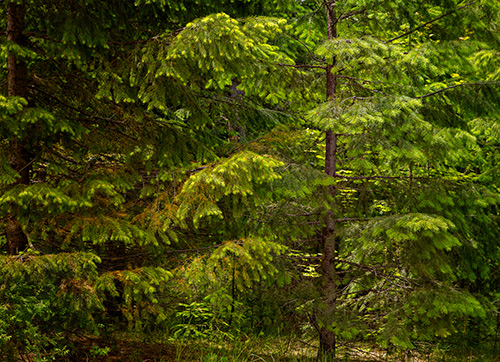
Trees
Just about anything can become interesting subject matter for a photographer. I was looking through images that I made on a family trip a while back, and came upon this one. I recall stopping to look at the river that was running swiftly over some rocks, but after stopping the car this tree caught my attention. The sun had gone behind some high clouds, softening the light, which is always a good thing. The leaves on a tree behind the pine tree here seemed to wrap around the trunk. I sat trying to figure out what it was that made the scene work and how to capture what I was feeling. I knew that the sun would soon return, so I made some quick decisions and this is what I came up with. I really like the new growth showing on the tips of the branches. The monochromatic color scheme always works for me as well. It is just a simple tree, but I like it. To me, simple is beautiful.
by tmoffett | Jul 26, 2012 | Black and White, Composition, Landscape, Photographic Philosophy, Photographic Technique
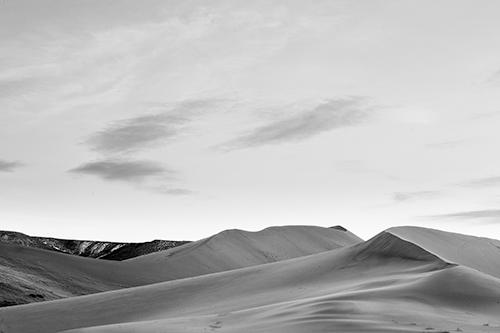
Bruneau Dunes
I was visiting with another photographer one day and we were talking about quality of light. I rise early and stay up late to photograph during the sweet light hours. This other photographer mentioned that you need the sweet light for color photography, but then switch to black and white during mid-day. I was very surprised to hear him say that and I one hundred percent disagree with him. Light quality is just that, quality. It really does not matter if you are shooting color or black and white. If you want quality light, you must work when the light is good. I have always taught my students that if you learn to shoot black and white, your color work will be much better, due to the fact that you must learn to see tones. Good tonal separation happens when the light is good. That is just another reason to photograph early and late.
The image above was made just as the sun was setting at Bruneau Dunes. The low sun is what is creating the highlight and shadows that sculpt the shape of the dunes. There is also balance between the dunes and the sky. None of this would have happened earlier in the day. For great landscape photography it is a must to photograph during the sweet light, otherwise you are just taking snapshots.
With the advent of digital photography, black and white photography is becoming a lost art. So many photographers just shoot a thousand images and then play with them on the computer to see what will look good as a monochrome image. It used to be, back in the days of film, that you would have to learn to see in black and white. We used filters to shift tones when we exposed the film, and then made additional adjustments in the development and printing stages to get the previsualized image on paper. Now we apply filters after the fact, and we get to watch the development in our “digital darkroom”… computer. It still seems so backward to me. Maybe I am just old school, but I believe that thinking before we press the shutter, like we used to do, will make us better photographers. Thinking more and shooting less is much more effective than the alternative. It will help put art back into our photographs.
by tmoffett | Jul 23, 2012 | Color, Composition, Critique, Landscape, Photographic Technique, Uncategorized
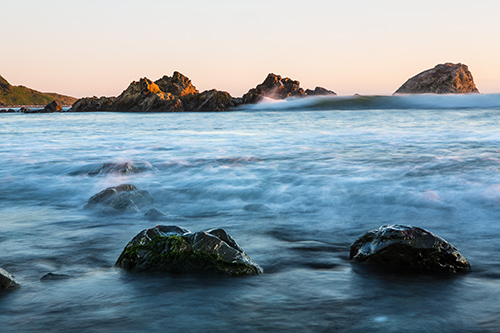
Ocean View, Crescent City, CA
I haven’t been out photographing for a few days and I am starting to get a bit antsy. I have been sitting in front of my computer getting some much needed work done, but I need to photograph. It doesn’t matter that I have a backlog of images to process and other tasks that need worked on, the need to make new images is always there. I guess that means I am a photographer. It is in my blood.
I pulled this image to post from my last trip to the coast. We were in Crescent City, California to photograph the Redwoods, but when I am close to the ocean, I will always find time to spend there. The evening I made this photograph, the sky was naked and colorless, so I really focused on the sea. One thing that I stress in my classes and workshops is to work the camera angles. Many times, especially at the ocean, I find photographers up on the beach, away from the water but shooting the water from a high angle. Not me. I like to be in the water. I try to find a lower angle to shoot from, as this will emphasize the foreground objects better. I have found that if I press my tripod down in the sand it becomes very stable. Unless a big wave slams into the tripod, it is remains quite stable in the water even at long shutter speeds. This image is a 1.3 second exposure, tripod legs buried under about 18 inches of water and waves hitting the tripod legs. The image is still tack sharp. When photographing this way you must keep an eye on the incoming waves, as occasionally a sleeper wave will come out of nowhere and you better be ready to move or risk soaking all of your gear. For this image, I actually wanted to get lower, but when I did, the incoming waves blocked the view of the rocky background too much.
One thing I really like about this image is not only the emphasis on the foreground rocks, but how the low angle also enlarges the size of the wave coming in. The wave creates a nice transition from ocean to rock in the background. I know it is hard to see in the small image here, but the water is packed with texture, detail and subtle color shifts, showing the warm light of the setting sun reflecting off of the highlights, but the deeper parts of the water remain a rich and vibrant blue. There is a lot of life in the finished print.
by tmoffett | Jul 19, 2012 | Black and White, Color, Composition, Photographic Technique
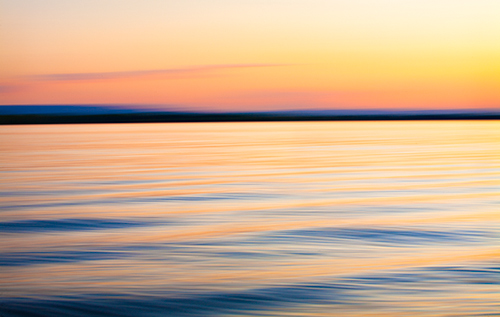
Complementary Reflections
It seems kind of strange to me to be talking about color. My photographic roots are in black and white. Before digital came into play, all of my personal work was black and white. I wouldn’t even carry color film with me. I loved what I could do with black and white. The entire process from shooting to processing to printing was fascinating to me. Expanding or compacting the tonal range of a scene and moving the tones to where I thought they should be was what I loved. I felt in complete control of the scene I was photographing. Then came digital.
The changes that digital brought along have been significant to me. I won’t go into them all now, that is for another time. The one change that I will discuss, though, is how it has affected my use of color. I still like to print in black and white, but I have added color as well to my repertoire.
Photographing in color first, and then converting the image to black and white, I began noticing how color could affect an image. I began studying the color composition of each of my photographs before converting them to black and white, and soon I began looking at the color in a scene and analyzing it before pressing the shutter. Little by little, color photographs began appearing in my portfolio. Now, it seems, that only those very special images make it to black and white.
The image above, Complementary Reflections, is one where color is everything. Without the color, the photograph would be a complete failure. The cool tones of the eastern sky reflecting in the water filled with the warm colors from the setting sun creates a feeling of excitement in the image that draws me in. When making this photograph, I got an idea to do a series of abstract images about color. Most of the photographs in the series so far I have made at the ocean, but occasionally I find just the right conditions on a lake or other body of water to photograph this way. It is fun and exciting to evolve and change. This change, to photograph in color, never would have happened for me if I had resisted the move to digital capture. It has been challenging at times, but always exciting!
This photograph also appears in my book Silent Solitude.
by tmoffett | Jul 17, 2012 | Color, Landscape, Photographic Philosophy
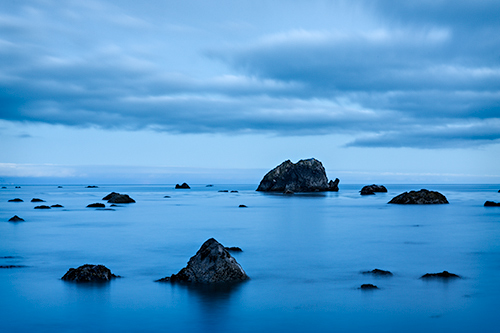
Still
The ocean, during the day is alive with activity. It is an exciting place to be. I love beachcombing with my kids collecting all kinds of interesting rocks and shells. Letting the waves crash into you and nearly knocking you down is a fun experience. Watching surfers catch the waves and riding them ashore, flying kites, tidepooling, and the list of activities goes on and on. When the sun sets, though, something magical happens. Everything seems to slow down, at least in my minds eye it does. The sounds become soothing, the fresh ocean breeze is calming to the soul. Yes, the waves of the rising tide are still crashing into the rock lined shore, but in my minds eye I see something entirely different. A long exposure smooths the surface of the wild sea and calms the waves crashing ashore. The cool blue sky bathes the scene in rich cool tones that create a very soothing effect on the viewer. This is what I come to the ocean for!
Previsualization, being able to recognize what it is I really see, and then being able to successfully render that image with the camera is what creative photography is about. Anyone can shoot a thousand images and then find a good one, but to be able to consistently render your feelings in an image is something entirely different. You must know your tools and understand how to use them if you are to create photographs that exhibit what your minds eye sees. It is not so much about what you physically see, but how you interpret what you see.







Recent Comments